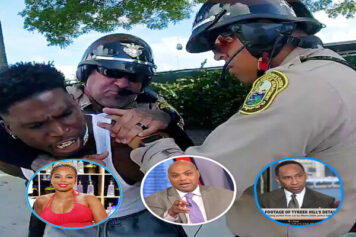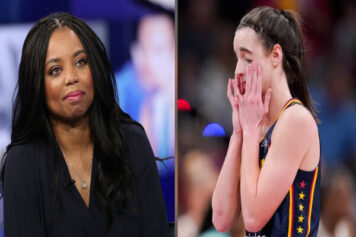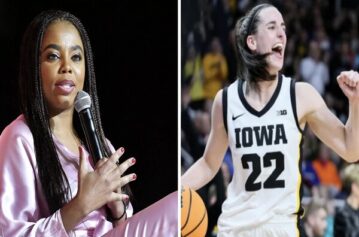This article was co-written by Shireen Ahmed.
***
In May, the Central Florida Institute for Diversity and Ethics in Sport released the 2018 Associated Press Sports Editors (APSE) Racial and Gender Report Card, a report about diversity in sports media. For those of us in the margins, the findings come as no surprise.
The bleak representation of women and people of color in sports media is a reality we live. Women of color are often underrepresented in managerial roles and senior editorial positions. In addition to regular staff jobs being few and far between, hiring practices of major sports outlets dont instill confidence that the status quo will change anytime soon.
mikeinbama on Twitter
@awfulannouncing “87.3% white, 74.6% white males, 4% Black journalists, 0 black females, 0 black editors, 7% Asian, 1.4% Hispanic, 12.6% Women.” By hiring a washed up, article recycling, fossil sports writer, The Athletic is looking to improve their diversity hiring.
As per the APSE report, ESPN boasts a significant number of diversity hires but the entire field is so vast and void of Women of Color, that tooting their horn seems unnecessary. As Carron J. Phillips wrote, ESPN has a large hand in pumping up numbers of diversity in staff but that doesnt solve the problem. The problem is industry-wide and it is the collective responsibility of all people in sports media to fix it.
We have seen people like Jemele Hill , Aishwarya Kumar and Katie Barnes of ESPN, Amira Rose Davis of the Burn It All Down Podcast, hockey writer Jashvina Shah, Sharon King Brown of All Heart in Hoop City, baseball writer Jen Mac Ramos and more publicly comment on the lack of representation and problematic exclusion of women of color and other underrepresented groups in sports media.
The Womens Media Center (WMC) has issued annual reports citing that Women of Color in sport journalism are represented at appallingly low numbers. And in their 2017 report, declared the number of female assistant sports editors at 100 U.S. and Canadian newspapers and websites fell by roughly half between 2012 and 2014from 17.2 percent of all such editors to 9.8 percent.
It is safe to assume that the least likely domain in which Women of Color appear is in sports journalism. It must be noted that in the WMC reports, there are no specific numbers for Women of Color because the numbers are so low. The fact that the data does not exist supports the idea that Women of Color are ridiculously excluded.
People of color in sports media rely on outlets led by other People of Color such The Shadow League to provide space for candid discussions on sports, systemic racism and diversity. If no such outlets existed, our powerful voices might never get published. To quote Indian writer Arundhati Roy: There’s really no such thing as the ‘voiceless’. There are only the deliberately silenced, or the preferably unheard.
For months, there has been a growing chorus of criticism surrounding popular sports site The Athletics hiring practices. Readers and journalists have commented on a glaring absence of marginalized people from their staff.
Title IX Hockey on Twitter
Will you release staff diversity figures @TheAthleticHQ
The Athletic seemingly answered by hiring more white women. Gregory Lee Jr, former president of the National Association of Black Journalists (NABJ), recently called the site to task via a series of tweets that concluded with: To recap my research, these are the diversity numbers @TheAthleticHQ: 87.3% white, 74.6% white males, 4% Black journalists, 0 black females, 0 black editors, 7% Asian, 1.4% Hispanic, 12.6% Women.
But women are being hired. Isn’t that progress? It isnt.
Why arent the women who have been hired bringing some of the many talented, qualified Women of Color to the attention of sites like The Athletic? Where are the allies in the industry?
Meredith Shiner on Twitter
@byjoelanderson @carronJphillips also that statement from The Athletic is some hot garbage, as they literally built an org from scratch! They could have hired anyone and made diversity in hiring a priority from Day One.
Diversity means not just women, but specifically women of color. In fairness, it is not only The Athletic that ought to receive a failing grade for not having Women of Color on staff. It is pretty much all outlets in the industry.
The responsibility to help better the landscape of sports media lies not only on the shoulders of the white, straight, male editors. It is also crucial for white women in the industry to speak up and amplify the voices of further marginalized women. Surely, we have not yet seen enough solidarity, discussions and passing of the proverbial mic. But once advised to be more proactive, there is no room for white women to feel wounded or attacked if it is suggested that they step up their game – or that they start playing.
Racial and gender identity matter in sports media. Suggesting that a piece on a racialized community ought to be written by a woman of color is not a difficult thing to do; to insist that a panel should include at least one woman of color is not arduous; to check in and share connections and contacts is not impossible.
The lack of diversity at all levels in press boxes and newsrooms is one of the industrys worst kept secrets. Hiring women of color not only gives sports media credibility and the opportunity to hire top talent, but also gives readers and viewers a broader range of perspectives on the teams and topics they love. It means producing a better product, telling better stories. Having journalists who are sensitive to issues of gender and race provides greater context and is vital to the life of media as a whole.
Speaking to a topic with which one has little understanding or knowledge, is reckless. Having white people opine on race in a way that lacks nuance is unprofessional at best. There are critical points in conversations, particularly with regards to marginalized folks, where those who are not the subject should make space, listen, and learn.
“sergio” on Twitter
Remember that @TheAthleticHQ chose to launch soccer without women’s coverage. They chose to promote their USWNT coverage in their top-level nav and not NWSL, MX Fem, WSL, UWCL. They chose to launch with 1 story written by a woman about a USWNT player and 9 about & written by men.
As two Black and Brown women, we often provide support to our melanated friends and colleagues. This is amplification of work, editing, and even encouragement to stay in this industry when the odds of success seem stacked against us. Simply put, we dont see enough support from white women – save a few sincere allies.
Not seeing yourself reflected in the media you consume is not encouraging. Women of Color are more than capable of professionalism, passion and brilliance. A brilliance that shines bright amidst the usual mediocrity of the almost 90% white men in the industry.
Understanding that diversity doesnt just mean women is a step in the right direction, but members of media should also be invested in the advancement of journalism in such a way that they are willing to make space for others- specifically, Women of Color.
It is important to ensure that opportunities are afforded to the people who deserve them. In order to make the industry a more inclusive and interesting place, a place from which profound stories emanate and celebrates our passion and love of sports, the work must be done.
Sports deserves this. And media needs it.



